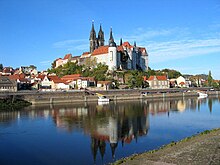Meissen (German spelling Meißen) is the oldest town in Saxony, Germany. Meißen was also once home to the local bishop and thus has a huge medieval cathedral and adjoining castle. It is very close to Dresden and the adjacent landscapes of the Saxon Wine Region and the mountain range of Saxon Switzerland. It is part of the cultural area of Central Germany.
Understand
[edit]
Meißen was the residence of the dukes of the March of Meissen which later became the Electorate of Saxony, before they moved to Dresden.
Later, the city gained cultural importance as the place where the first European porcelain was invented. The factory is still producing porcelain today under the Meissen brand and can be visited together with the porcelain museum.
The city was home to 28,000 people in 2020.
Tourist information
[edit]Get in
[edit]By plane
[edit]The nearest international airport is in Dresden (DRS IATA). If you are arriving from further away it is more likely you will fly to Leipzig-Halle (near Schkeuditz, LEJ IATA) instead, as it offers more connections.
By train
[edit]Meißen has three train stops: Meißen, Meißen-Altstadt (old town) and Meißen-Triebischtal, all served by the S-Bahn from Dresden every 30 minutes. The Meißen station is on the eastern banks of the Elbe, across the river from the old town. It is best for tourists is to use the Meißen-Altstadt station. The old town and the tourist sights are within walking distance from there.
Meissen is part of the VVO transport executive, Tariff-zone 50. All VVO-tickets including this zone can be used on buses, regional trains and (most) ferries.
- 1 Meissen railway station (Bahnhof Meißen).
- 2 Meissen Altstadt station (Bahnhof Meißen Altstadt), Neumarkt 5.
- 3 Meissen Triebischtal station (Bahnhof Meißen Triebischtal), Hirschbergstr. 30.
By car
[edit]Meissen is linked to the A14 and the A4 express ways.
By boat
[edit]The city has a steam boat (literally) connection to Dresden which is part of a larger steam boat network which connects places along the Elbe river in the wider Dresden area.
Get around
[edit]Walk. The old town of Meißen is not that big, but very pretty. Up to the Albrechtsburg it is rather steep though. There is a tourist bus doing several round trip tours daily, which might be an option if you're lazy or mobility impaired. A couple of years ago the city of Meißen built an escalator to the upper parts of town, but it has been out of order due to mechanic failures more than it has been in use.
Public transport
[edit]All information about public transport is available at the homepage of the Public transport authority Upper Elbe (VVO). There are three urban bus lines (A, B, C), many regional buses and a sight-seeing route (E). Here is a map of public transport.
S1 takes you to Dresden in 36 minutes. All lines (except E) are connected at Busbahnhof (central bus station) Meißen.
See
[edit]

- The porcelain factory and museum, Talstraße 9, ☏ +49 3521 468-0. A museum dedicated to the porcelain that has made the town famous.
- 1 Albrechtsburg. A castle in Meißen.
- 2 Meissen cathedral (Meißner Dom).
- It is worth taking a look at the town and its old beautiful houses.
Do
[edit]Meißen is a rather quiet town and there isn't all that much you can do that doesn't have to do with either porcelain, wine or the castle and former residence.
Buy
[edit]- Weinhaus Schuh, Zaschendorfer Str. 2, Sörnewitz (between Meißen and Coswig), ☏ +49 352384810, info@weinhaus-schuh.de. M–F 10:00–18:00, Sa 10:00–17:00; Su 11:00–16:00. A private winehouse of the Schuh family. Wine tasting, sale, excursion to the vineyard, cafe, and a small hotel (guest house).
Eat
[edit]Perhaps the weirdest local speciality is the "Meißner Fummel", a very brittle piece of dough that tastes of basically nothing and consists mostly of air. It was supposedly invented to be transported along with the famous Meissen china to prove that any breakage was not due to the recklessness of the coach-driver. Some bakeries sell it and you are bound to be told about them in any guided tour of the city. Tasting is often included.
- Vincenz Richter Restaurant, An der Frauenkirche 12, 01662 Meissen, ☏ +49 3521 453285, restaurant@vincenz-richter.de. Tu-Su from 12:00, Su until 18:00, M closed. Traditional wine house and restaurant since the 1870s.
- 1 Gasthaus „Meißner Groschen“, Rosengasse 12 (Altstadt am Tuchmachertor), ☏ +49 3521 4764414..
Drink
[edit]Meissen is the easternmost wine area in Germany and on the northeastern edge of winegrowing in Europe. Meissen wines are mostly white wines and they are, given their location, rather on the dry side. The most common grapes are Riesling, Müller-Thurgau, and Weißburgunder. Red wines are rather uncommon. As the wine area is not too large and hardly able to meet the demand, Meissen wines are rather scarce and therefore pricey.
Sleep
[edit]- Herberge Orange, Siebeneichener Straße 34, ☏ +49 3521 454334, info@herberge-orange.de. A youth hostel close to the Elbe. from €15 per person.
- 1 Hotel „Siebeneichen“, Wilsdruffer Str. 35, ☏ +49 3521 47760, fax: +49 3521 477650, hotel-siebeneichen@t-online.de..
- 2 Dorint Parkhotel Meißen (Parkhotel Meissen), Hafenstraße 27-31, 01662 Meißen, ☏ +49 3521-72250, info@parkhotel-meissen.de. Hotel with Art Nouveau charm and modernity, situated directly on the banks of the Elbe with a view of Albrechtsburg Castle and the cathedral of Meissen. from €91 per room/night.
Go next
[edit]- Radebeul (15 km southeast; 15 minutes by S-Bahn) – villas, vineyards, steam railway
- Moritzburg (18 km east) – fairytale castle and stud farm
- Dresden (25 km southeast; half hour by S-Bahn) – capital of Saxony with palaces and art museums
- Riesa (25 km northwest)
- Freiberg (35 km southwest)
- Saxon Switzerland (70 km southeast; 1–1½ hr by S-Bahn) – picturesque mountain region for hiking and climbing


